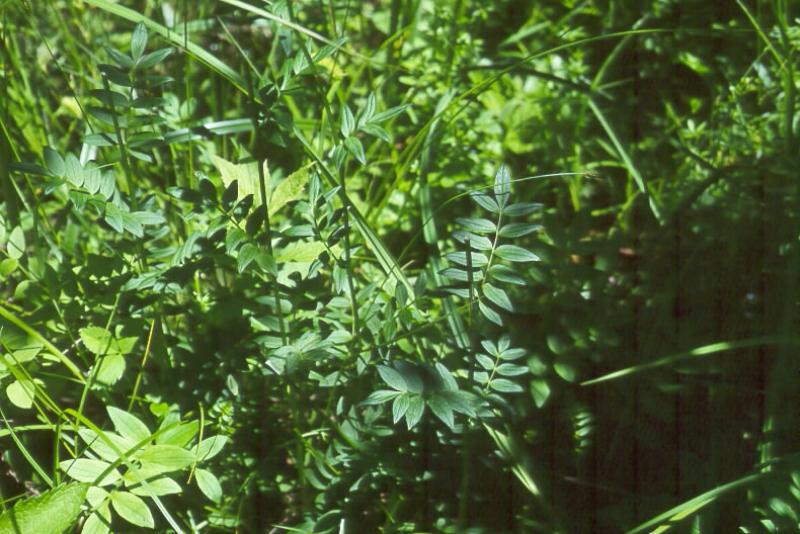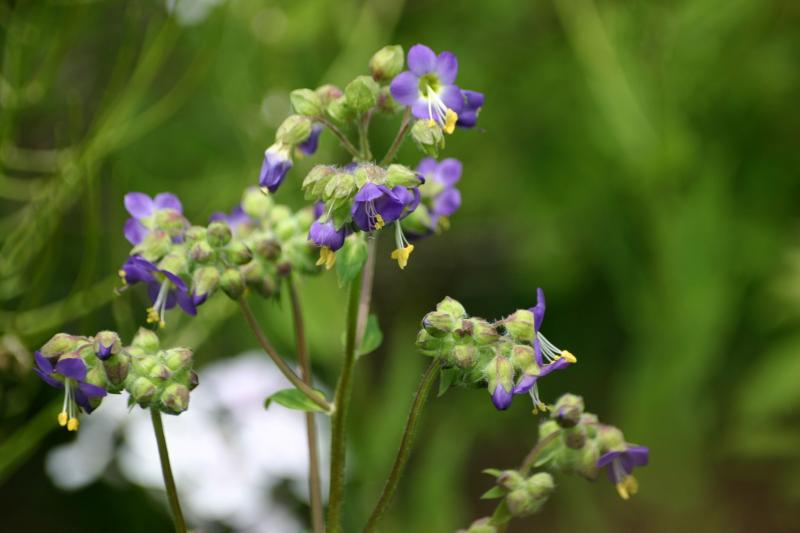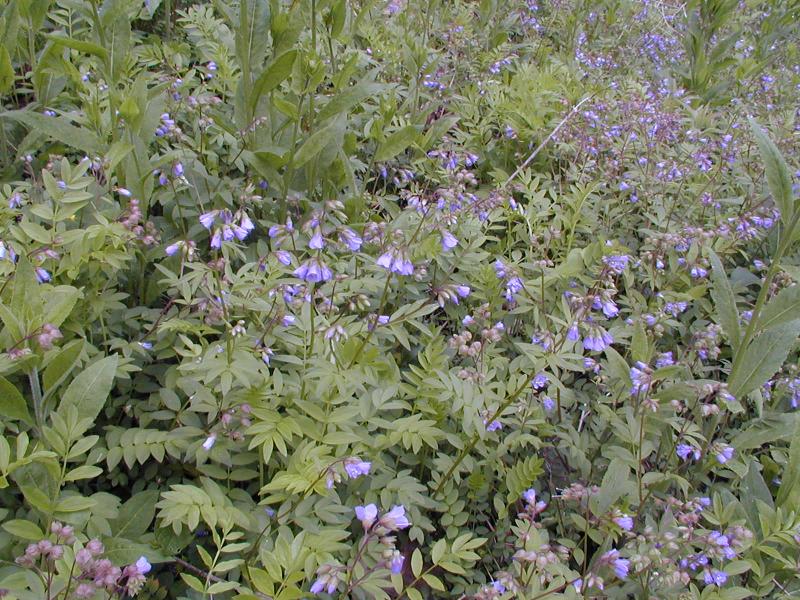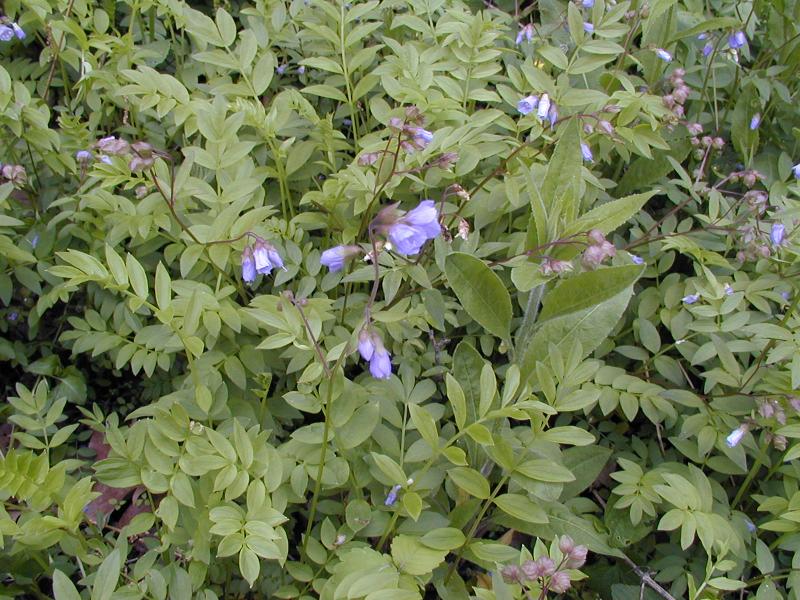Jacob's Ladder
Polemonium vanbruntiae Britt.
- Class
- Dicotyledoneae (Dicots)
- Family
- Polemoniaceae (Phlox Family)
- State Protection
- Rare
A plant listed as Rare by New York State. Removal or damage without the consent of the landowner is prohibited.
- Federal Protection
- Not Listed
- State Conservation Status Rank
- S3
Vulnerable in New York - Vulnerable to disappearing from New York due to rarity or other factors (but not currently imperiled); typically 21 to 80 populations or locations in New York, few individuals, restricted range, few remaining acres (or miles of stream), and/or recent and widespread declines.
- Global Conservation Status Rank
- G3G4
Vulnerable globally, or Apparently Secure - At moderate risk of extinction, with relatively few populations or locations in the world, few individuals, and/or restricted range; or uncommon but not rare globally; may be rare in some parts of its range; possibly some cause for long-term concern due to declines or other factors. More information is needed to assign either G3 or G4.
Summary
Did you know?
Jacob's-ladder was described as a new species in 1870 by N. L. Britton of the New York Botanical Garden and named after Mrs. Cornelius Van Brunt who made excellent collections from the Catskill Mountains of New York. New York has the greatest number of populations and some of the largest populations of Jacob's-ladder in the world.
State Ranking Justification
There are 31 known sites and over 20 historical populations. A review of the known sites may show a high level of interaction and gene flow between the sites, whereby multiple "sites" may represent a single population. As a rough guess, New York likely has 10-15 populations represented by 31 sub-populations. Many of these sites are in isolated wetlands and/or within protected landscapes. While rare, this plant is well-protected within New York.
Short-term Trends
Most of our plants are in large, fairly isolated wetlands that have not undergone very much change in recent years. In a resurvey of 28 of the populations in 2003 there were seven sites with increased numbers, eight sites where numbers had decreased, 12 sites where the numbers were about the same, and one site with no previous numbers. Six sites may have been extirpated. This fluctuation in numbers is to be expected because of the dependence of this plant on water levels. Overall, populations seem stable but this trend will become clearer with more surveys over multiple years.
Long-term Trends
The number of plants and the number of sites where this plant occurs seems stable over time. Twelve historical sites have been searched and no plants have been found but many new sites have been found since 1985 (mainly due to increased survey efforts). This plant occurs in large wetlands that are fairly isolated and should be protected over time but it has also been recorded from small wetlands, especially along roadsides, where its long term survival is less secure.
Conservation and Management
Threats
Succession of open wetland habitats sometimes occurs but the threat is not widespread and does not occur rapidly.
Conservation Strategies and Management Practices
With further research into this plant's response to beaver activity, better management of beaver activities in relation to the plant's habitat could be undertaken.
Research Needs
Research could be done into how this plant responds to beaver activity. We would like to know what kind of beaver activity is necessary and on what time frame for optimum Polemonium success (i.e., reproductive success, large population size, individuals of good vigor). We would also like to know how this plant responds to changes in habitat by seed banking.
Habitat
Habitat
This showy plant is found in wet meadows, swamps, seepage areas, beaver meadows, edges of streams, and sometimes ditches. It may be found under closed canopy, but seems to only flower regularly in open areas. Many of the sites are associated with a beaver impoundment, a high elevation and often high gradient seepage slope, or a narrow, meandering stream (New York Natural Heritage Program 2005). Rare in sphagnous glades, swamps, or marshes (Rhoads and Block 2000). Swamps and stream-banks (Gleason and Cronquist 1991). Wooded swamps, bottoms, sphagnous bogs, and mossy glades (Fernald 1970).
Associated Ecological Communities
- Hemlock-hardwood swamp
(guide)
A swamp that occurs on mineral soils and deep muck in depressions which receive groundwater discharge. These swamps usually have a fairly closed canopy (70 to 90% cover), sparse shrub layer, and low species diversity. The tree canopy is typically dominated by eastern hemlock and co-dominated by yellow birch and red maple.
- Marsh headwater stream
(guide)
The aquatic community of a small, marshy perennial brook with a very low gradient, slow flow rate, and cool to warm water that flows through a marsh, fen, or swamp where a stream system originates. These streams usually have clearly distinguished meanders (i.e., high sinuosity) and are in unconfined landscapes.
- Red maple-tamarack peat swamp*
(guide)
A swamp that occurs on organic soils (peat or muck) in poorly drained depressions. These swamps are often spring fed or enriched by seepage of mineral-rich groundwater resulting in a stable water table and continually saturated soil. The dominant trees are red maple and tamarack. These species usually form an open canopy (50 to 70% cover) with numerous small openings dominated by shrubs or sedges.
- Rocky headwater stream*
(guide)
The aquatic community of a small- to moderate-sized perennial rocky stream typically with a moderate to steep gradient, and cold water that flows over eroded bedrock, boulders, or cobbles in the area where a stream system originates.
- Sedge meadow
(guide)
A wet meadow community that has organic soils (muck or fibrous peat). Soils are permanently saturated and seasonally flooded. The dominant herbs must be members of the sedge family, typically of the genus Carex.
- Shallow emergent marsh
(guide)
A marsh meadow community that occurs on soils that are permanently saturated and seasonally flooded. This marsh is better drained than a deep emergent marsh; water depths may range from 6 in to 3.3 ft (15 cm to 1 m) during flood stages, but the water level usually drops by mid to late summer and the soil is exposed during an average year.
- Shrub swamp
(guide)
An inland wetland dominated by tall shrubs that occurs along the shore of a lake or river, in a wet depression or valley not associated with lakes, or as a transition zone between a marsh, fen, or bog and a swamp or upland community. Shrub swamps are very common and quite variable.
- Spruce-fir swamp
(guide)
A conifer swamp that typically occurs in a drainage basin but also can occur at the edge of a lake or pond or along gentle slopes of islands. These swamps are usually dense, with a fairly closed canopy (80 to 90% cover). The dominant tree is usually red spruce. Codominant trees include balsam fir and red maple. In the Catskills, balsam fir may be absent, and in the Adirondacks, black spruce or white spruce may replace red spruce as a dominant tree.
* probable association but not confirmed.
Associated Species
- Alnus incana ssp. rugosa (speckled alder)
- Athyrium filix-femina
- Calamagrostis canadensis
- Caltha palustris (marsh-marigold)
- Carex prasina (elegant drooping sedge)
- Carex scabrata (rough sedge)
- Carex stipata
- Carex stricta (tussock sedge)
- Clematis virginiana (virgin's-bower)
- Dryopteris intermedia (evergreen wood fern, fancy wood fern, common wood fern)
- Eupatorium maculatum
- Geum rivale (purple avens, water avens)
- Hydrophyllum virginianum
- Ilex verticillata (common winterberry)
- Impatiens capensis (spotted jewelweed, spotted touch-me-not)
- Iris virginica (southern blue flag)
- Onoclea sensibilis (sensitive fern)
- Osmunda cinnamomea
- Osmunda claytoniana (interrupted fern)
- Platanthera dilatata
- Ranunculus hispidus var. caricetorum
- Ranunculus recurvatus
- Senecio aureus
- Typha latifolia (wide-leaved cat-tail)
- Veratrum viride (false hellebore, Indian corn lily)
Range
New York State Distribution
This showy plant is found in and adjacent to areas within the Catskill Mountains, Tug Hill Plateau, and central New York's Allegheny Plateau.
Global Distribution
This plant extends from Quebec south through Maine, Vermont, New York, Pennsylvania, West Virginia, and Maryland. It is considered extirpated from New Jersey (only one population ever known) and New Brunswick. The majority of populations are located within the Catskill Mountains, Tug Hill Plateau, and Allegany Plateau of New York State.
Identification Comments
General Description
Jacob's-ladder is a tall erect plant that is easily seen when in flower. It grows up to 3 feet tall and has alternate leaves that sport a ladder-like arrangement of 7-10 pairs of lance-shaped leaflets and one terminal leaflet. The numerous nodding flowers at the top of the plant are quite striking with five, deep blue-purple petals that have yellow centers and long, bright yellow and white stamens that hang down.
Identifying Characteristics
This showy wetland plant may grow to a meter or more in height and spreads by horizontal rhizomes. This often results in plants being locally abundant. The long leaves usually have 15-21 leaflets, these are typically 1-3 cm apart. The blue-purple flowers are about 1.5 cm long, and have stamens and a style that are much exserted from the corolla.
Best Life Stage for Proper Identification
This plant is easiest to identify in flower. To verify the identification, collect a specimen, but only if the population size is large enough (use your best judgement, but as a general rule collections should only be made if there are more than 100 stems present). For small populations, multiple photos of the flowers and leaves should allow someone to verify the identification.
Similar Species
Polemonium reptans and Polemonium caeruleum both have stamens that are shorter than the corolla or only slightly exserted. Polemonium caeruleum has a single deep rooted stem with no horizontal rhizomes and 19-29 leaflets on the larger leaves. The leaflets are usually 1 cm or even less apart. Polemonium reptans is a low growing plant, rarely more than a half meter tall. The larger leaves of Polemonium reptans have 11-17 leaflets.
Best Time to See
This showy plant flowers mid-June to late-July, with fruiting and vegetative plants persisting until the first frost. When under heavy canopy, the plants often do not flower. Surveys are most successful when conducted during the peak flowering period. Those familar with the plant may be able to identify it vegetatively, but it is much more difficult to locate vegetative plants.
- Vegetative
- Flowering
- Fruiting
The time of year you would expect to find Jacob's Ladder vegetative, flowering, and fruiting in New York.
Jacob's Ladder Images
Images of Similar Species
Taxonomy
Jacob's Ladder
Polemonium vanbruntiae Britt.
- Kingdom Plantae
- Phylum Anthophyta
- Class Dicotyledoneae
(Dicots)
- Order Solanales
- Family Polemoniaceae (Phlox Family)
- Order Solanales
- Class Dicotyledoneae
(Dicots)
- Phylum Anthophyta
Additional Common Names
- Appalachian Jacob's Ladder
- Charity
- Vanbrunt's Polemonium
Synonyms
- Polemonium caeruleum ssp. vanbruntiae (Britt.) J.F. Davids.
Additional Resources
Best Identification Reference
Gleason, Henry A. and A. Cronquist. 1991. Manual of Vascular Plants of Northeastern United States and Adjacent Canada. The New York Botanical Garden, Bronx, New York. 910 pp.
Other References
Britton, N.L. 1870. New or Noteworthy North American Phanerogams. VI. Bulletin of the Torrey Botanical Club. 219-226.
Davidson, John F. 1950. The Genus Polemonium [Tournefort] L. Univ. Calif. Publ. Bot. 23(5):209-282.
Holmgren, Noel. 1998. The Illustrated Companion to Gleason and Cronquist's Manual. Illustrations of the Vascular Plants of Northeastern United States and Adjacent Canada. The New York Botanical Garden, Bronx, New York.
Mitchell, Richard S. and Gordon C. Tucker. 1997. Revised Checklist of New York State Plants. Contributions to a Flora of New York State. Checklist IV. Bulletin No. 490. New York State Museum. Albany, NY. 400 pp.
New York Natural Heritage Program. 2010. Biotics database. New York Natural Heritage Program. New York State Department of Environmental Conservation. Albany, NY.
New York Natural Heritage Program. 2024. New York Natural Heritage Program Databases. Albany, NY.
Rhoads, Ann F. and Timothy A. Block. 2000. The Plants of Pennsylvania, an Illustrated Manual. University of Pennsylvania Press, Philadelphia, PA.
Weldy, T. and D. Werier. 2010. New York flora atlas. [S.M. Landry, K.N. Campbell, and L.D. Mabe (original application development), Florida Center for Community Design and Research http://www.fccdr.usf.edu/. University of South Florida http://www.usf.edu/]. New York Flora Association http://newyork.plantatlas.usf.edu/, Albany, New York
Wherry, E.T. 1935. Polemonuim and Polemoniella in the Eastern United States. Bartonia 17:5-12.
Links
About This Guide
Information for this guide was last updated on: January 15, 2009
Please cite this page as:
New York Natural Heritage Program. 2024.
Online Conservation Guide for
Polemonium vanbruntiae.
Available from: https://guides.nynhp.org/jacobs-ladder/.
Accessed July 26, 2024.





